For the 2025 school year, there are 2 public elementary schools serving 922 students in Berkshire Local School District. This district's average elementary testing ranking is 6/10, which is in the top 50% of public elementary schools in Ohio.
Public Elementary Schools in Berkshire Local School District have an average math proficiency score of 60% (versus the Ohio public elementary school average of 54%), and reading proficiency score of 64% (versus the 59% statewide average).
Minority enrollment is 6% of the student body (majority Hispanic), which is less than the Ohio public elementary school average of 35% (majority Black).
Overview
This School District
This State (OH)
# Schools
4 Schools
2,458 Schools
# Students
1,370 Students
1,091,015 Students
# Teachers
66 Teachers
63,050 Teachers
Student : Teacher Ratio
21:1
21:1
District Rank
Berkshire Local School District, which is ranked within the top 50% of all 918 school districts in Ohio (based off of combined math and reading proficiency testing data) for the 2021-2022 school year.
The school district's graduation rate of 85-89% has decreased from 95% over five school years.
Overall District Rank
#315 out of 929 school districts
(Top 50%)
(Top 50%)
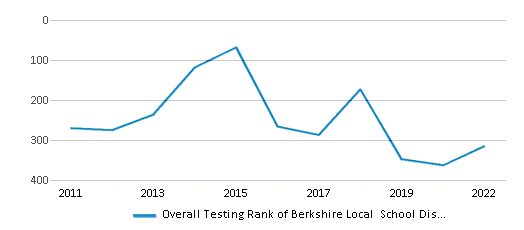
Math Test Scores (% Proficient)
58%
52%
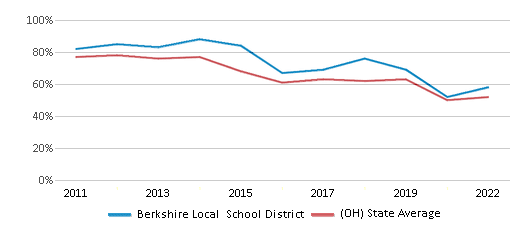
Reading/Language Arts Test Scores (% Proficient)
65%
60%
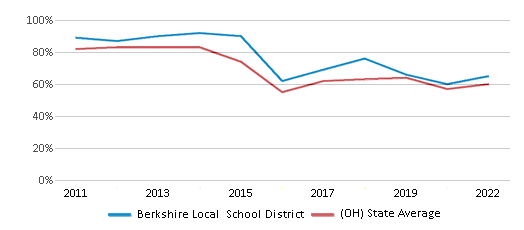
Science Test Scores (% Proficient)
66%
63%
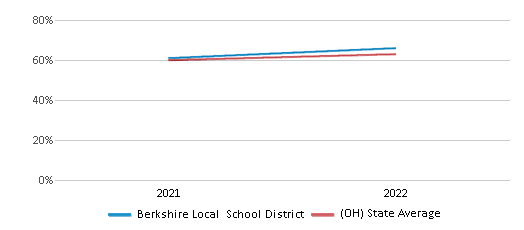
Graduation Rate
85-89%
86%
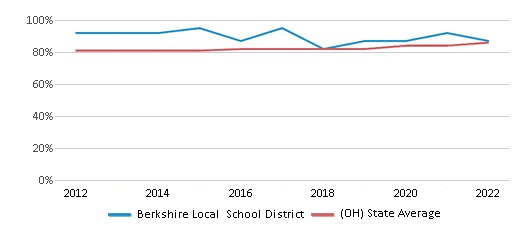
Students by Ethnicity:
Diversity Score
0.11
0.55
# American Indian Students
1 Student
1,574 Students
% American Indian Students
n/a
n/a
# Asian Students
3 Students
32,328 Students
% Asian Students
n/a
3%
# Hispanic Students
30 Students
86,617 Students
% Hispanic Students
2%
8%
# Black Students
4 Students
192,244 Students
% Black Students
n/a
18%
# White Students
1,292 Students
704,631 Students
% White Students
95%
64%
# Hawaiian Students
n/a
1,092 Students
% Hawaiian Students
n/a
n/a
# Two or more races Students
40 Students
72,529 Students
% of Two or more races Students
3%
7%
Students by Grade:
# Students in PK Grade:
3
30,887
# Students in K Grade:
101
112,601
# Students in 1st Grade:
107
119,240
# Students in 2nd Grade:
116
123,668
# Students in 3rd Grade:
104
116,979
# Students in 4th Grade:
98
120,578
# Students in 5th Grade:
93
121,564
# Students in 6th Grade:
93
121,429
# Students in 7th Grade:
109
90,010
# Students in 8th Grade:
101
88,363
# Students in 9th Grade:
114
11,363
# Students in 10th Grade:
105
10,664
# Students in 11th Grade:
109
12,317
# Students in 12th Grade:
117
11,352
# Ungraded Students:
-
-
District Revenue and Spending
The revenue/student of $26,001 is higher than the state median of $17,287. The school district revenue/student has stayed relatively flat over four school years.
The school district's spending/student of $28,623 is higher than the state median of $17,235. The school district spending/student has stayed relatively flat over four school years.
Total Revenue
$36 MM
$28,879 MM
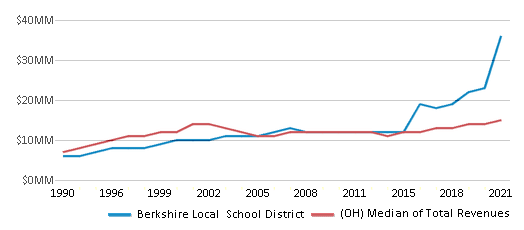
Spending
$39 MM
$28,792 MM

Revenue / Student
$26,001
$17,287
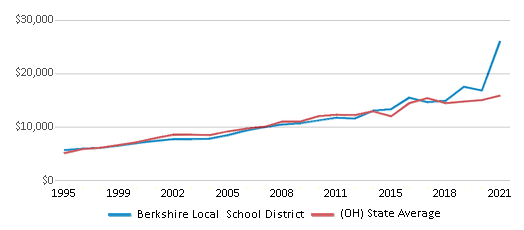
Spending / Student
$28,623
$17,235
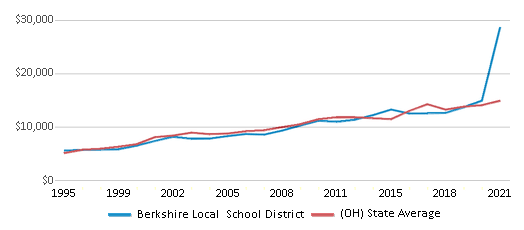
Best Berkshire Local School District Public Elementary Schools (2025)
School
(Math and Reading Proficiency)
(Math and Reading Proficiency)
Location
Grades
Students
Rank: #11.
Berkshire Elementary School
(Math: 70-74% | Reading: 70-74%)
Rank:
Rank:
8/
Top 30%10
14155 Claridon Troy Rd
Burton, OH 44021
(440) 298-3314
Burton, OH 44021
(440) 298-3314
Grades: K-4
| 526 students
Rank: #22.
Berkshire Middle School
(Math: 55% | Reading: 61%)
Rank:
Rank:
6/
Top 50%10
14155 Claridon Troy Rd
Burton, OH 44021
(440) 834-4616
Burton, OH 44021
(440) 834-4616
Grades: 5-8
| 396 students
Recent Articles

Year-Round Or Traditional Schedule?
Which is more appropriate for your child? A year-round attendance schedule or traditional schedule? We look at the pros and cons.

Why You Should Encourage Your Child to Join a Sports Team
Participating in team sports has a great many benefits for children, there is no doubt. In this article you will learn what those benefits are.

White Students are Now the Minority in U.S. Public Schools
Increasing birth rates among immigrant families from Asia and Central and South America, combined with lower birth rates among white families, means that for the first time in history, public school students in the United States are majority-minority. This shift in demographics poses difficulties for schools as they work to accommodate children of varying language abilities and socio-economic backgrounds.





